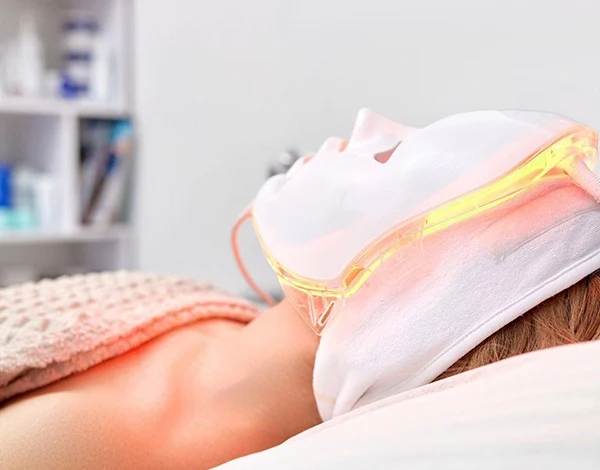Is it safe to use LED mask during pregnancy? Only the effect on the fetus is discussed
Short answer: Yes—current evidence indicates that at-home LED facial masks are safe to keep using while you are pregnant.
The blue (≈ 415 nm), vermelho (≈ 630–660 nm) and near-infra-red (≈830-850 nm) photons they emit are non-ionizing, penetrate only the upper 1–2 mm of skin, and therefore cannot reach or heat the uterus or the fetus.
Moreover, LED mask treatment is limited to the facial area — the abdomen is completely outside the range of light exposure. Unless you imagine that light can penetrate through your face and reach your abdomen — which, of course, is impossible in reality.
That said, if you have any medical concerns—or just want peace of mind—it’s always a good idea to ask your OB/GYN or dermatologist before use.

Why LED Masks Are Generally Safe During Pregnancy
You’re already exposed to similar types of light every day—through natural sunlight.
Daylight contains red light, luz azul, and near-infrared light. These are the same types of light used in LED masks. The only difference? The sun also emits UV light, which LED masks do not.
UV rays can be harmful in excess. But red, blue, and near-infrared light have been studied extensively and are considered safe for skin. In fact, light exposure from the sun can benefit both you and your baby during pregnancy—when done in moderation.
Benefits of Sunlight During Pregnancy
Here’s what studies say about light exposure from the sun during pregnancy:
| Beneficiar | What the Research Says |
|---|---|
| Boosts Vitamin D | Moderate sunlight helps the body produce vitamin D, which supports bone development and immune health. |
| Lowers Blood Pressure | A 2023 clinical trial found that 20 minutes of sunlight daily reduced systolic blood pressure in pregnant women. |
| Reduces Risk of Pre-eclampsia | A WHO review showed vitamin D from sunlight may lower the risk of pre-eclampsia. |
| Increases Birth Weight | A large cohort study in China linked second-trimester sun exposure to higher birth weights. |
| Lowers Risk of Preterm Birth | A study in Scotland found that women with more sunlight exposure in early pregnancy had fewer preterm births. |
| Improves Baby’s Bone Health | Research from the UK showed that children born to women who had more UVB exposure had better bone mass at age 10. |
These studies reinforce a simple truth: your body and your baby already benefit from non-harmful light exposure. LED masks operate in the same safe light spectrum, but in a controlled, targeted way.
What Light Wavelengths Do LED Masks Use?
LED face masks typically use three main types of light:
| Tipo de luz | Comprimento de onda | Effect |
|---|---|---|
| Luz azul | ~415 nm | Mata bactérias causadoras de acne (especially C. acnes). |
| Luz vermelha | ~630–660 nm | Stimulates collagen, reduz a inflamação. |
| Luz do infravermelho próximo | ~830 nm | Promotes healing, reduces pain, melhora a circulação. |
*All effects demonstrated in split-face or half-body trials with no adverse pregnancy signals.
Depth check: Optical modeling and biopsy measurements place red light’s mean attenuation length at ≈ 1 mm e 830 nm at ≈ 2 mm in human skin—orders of magnitude short of fetal tissue.
That’s nowhere near deep enough to affect your uterus or developing fetus.
These wavelengths are also non-thermal at the intensity used in masks, meaning they don’t heat up the skin.
What the Science Says
Studies on red and near-infrared light therapy have shown improvements in skin health, healing, and inflammation reduction—with no reported harm to pregnant women.
Phototherapy is already used in pregnancy for conditions like psoriasis, using even stronger medical-grade devices than LED masks.
LED masks are cosmetic-level devices with far lower power levels. They’re designed for at-home skincare—not medical treatment.
Tips for Using LED Masks While Pregnant
If you choose to use your LED mask during pregnancy, keep these tips in mind:
Choose a reputable, FDA-cleared brand with clear safety instructions.
Stick to the recommended time (usually 10–20 minutes per session).
Use on clean, bare skin—skip harsh skincare actives like retinoids before and after.
Avoid use if you have certain conditions, like melasma, lupus, or extreme photosensitivity.
Check with your OB/GYN or dermatologist if you’re unsure. Every pregnancy is different.
Final Thoughts
Using an LED face mask during pregnancy is generally considered safe. These devices use light wavelengths you’re already exposed to in everyday life—like sunlight—but in a more controlled, localized way.
As long as you follow instructions and use common sense, there’s no strong evidence that LED masks pose any risk to your baby. And for extra reassurance, just check in with your healthcare provider.


